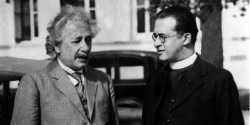[246 / 37 / 94]
Quoted By: >>15040221 >>15040225 >>15040226 >>15040233 >>15040261 >>15040269 >>15040296 >>15040301 >>15040305 >>15040309 >>15040355 >>15040372 >>15040378 >>15040389 >>15040393 >>15040394 >>15040398 >>15040401 >>15040411 >>15040417 >>15040419 >>15040435 >>15040436 >>15040438 >>15040439 >>15040440 >>15040443 >>15040446 >>15040452 >>15040456 >>15040461
Modern physics will be forever changed and the talking points and beliefs of today will be gone tomorrow. Why? An experiment that was done in Glasgow, Scotland, which collaborated with multiple physicists across the world, has uprooted the very foundation of modern day physics. This realization has not yet taken hold in the scientific community. Once the realization does set in, the collective work of physicists form the past 90 years will have to be reworked, forever changing how we understand the universe.
The foundation of modern physics started in 1927 when Georges Lemaître proposed that the universe was expanding from a singularity, which he called the cosmic egg (Ref 1). In 1929, Edward Hubble confirmed this hypothesis by observing the distances to faraway galaxies were strongly correlated with their redshifts (Ref 2). Today the cosmic egg is known as the big bang theory, renamed by Sir Fred Hoyle, in attempt to ridicule the theory (Ref 3). Despite Sir Fred Hoyle’s attempt, the big bang theory has been in the lime light as the truth in physics and the public at large.
The evidence for the big bang theory is the work done by Edward Hubble, but the legitimacy of this evidence was not questioned outside of a few prominent figures. The whole of academia taught the next generations this doctrine without ever critiquing the theory. Only within the Big Bang Theory has minor details been critiqued which gave birth to sub-theories and beliefs. Never before has the legitimacy of the premise been question, until now.
Hubble’s law – “all galaxies seemed to be receding from us with velocities that increased in proportion to their distance from us.” (Ref 2)
The foundation of modern physics started in 1927 when Georges Lemaître proposed that the universe was expanding from a singularity, which he called the cosmic egg (Ref 1). In 1929, Edward Hubble confirmed this hypothesis by observing the distances to faraway galaxies were strongly correlated with their redshifts (Ref 2). Today the cosmic egg is known as the big bang theory, renamed by Sir Fred Hoyle, in attempt to ridicule the theory (Ref 3). Despite Sir Fred Hoyle’s attempt, the big bang theory has been in the lime light as the truth in physics and the public at large.
The evidence for the big bang theory is the work done by Edward Hubble, but the legitimacy of this evidence was not questioned outside of a few prominent figures. The whole of academia taught the next generations this doctrine without ever critiquing the theory. Only within the Big Bang Theory has minor details been critiqued which gave birth to sub-theories and beliefs. Never before has the legitimacy of the premise been question, until now.
Hubble’s law – “all galaxies seemed to be receding from us with velocities that increased in proportion to their distance from us.” (Ref 2)

